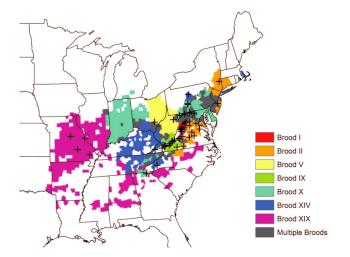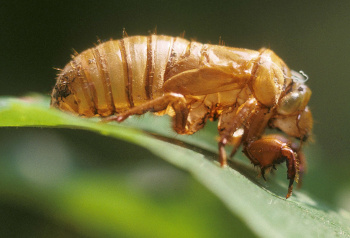Cicada Apocalypse
April 29, 2024
Humans are capable of effective
communication in a
room where many people are
loudly talking all at once, a
phenomenon known as the
cocktail party effect.
Communication between
computers is more limited, since a
collision of two or more
devices sending
data at the same time prevents any
data transfer. Data transfer in the
early days of computing was by a simple
serial interface known as
RS-232, and collisions were avoided using signals known as
RS-232 RTS/CTS for
Request To Send and
Clear To Send. These were sent on individual signal
wires; and, later, the
IEEE 802.11 RTS/CTS protocol was developed for
wireless networking.
WiFi now uses a collision avoidance protocol known as
carrier-sense multiple access with collision avoidance (CSMA/CA)

A 9-pin male serial port connector, once ubiquitous on desktop computers and laptop computers, but rarely seen today.
Rarer still is its 25-pin ancestor, the only connector specified in the original RS-232 standard. (Wikimedia Commons image)
The
cicada, an
insect of the
order Hemiptera, has about 2500
species worldwide. One curious
genus, the
Magicicada, is
native to
North America, and it has an
adaptation to collision avoidance of two variants. These cicadas remain in a
dormant underground nymph form for long periods, with one
emerging every 13
years, and the other every 17 years. Thirteen and seventeen are
prime numbers, and the smallest
composite number with which they
divide is 221.
This means that these variants will
simultaneously emerge every 221 years. The last such emergence was in 1803, and the next will be this year.[1-3] More than a
trillion cicadas are estimated to emerge in the
contiguous United States this year, and there might be as many as 1.5 million per
acre.[2] In 2024, the 17-year variant will emerge
geographically adjacent to the 13-year variant, but little overlap is expected; so, no cicada
apocalypse.[2]

A North American cicada.
My children would discover nymphd of these during their backyard excavations of our Northern New Jersey home.
(U.S. Bureau of Labor Statistics image. Click for larger image.)
Aristotle (384 BC-322 BC) devoted a few
paragraphs of his
History of Animals (4th century BC) to the cicada.[4]
The cicada is not found where there are no trees... They lay their eggs in fallow lands... The grub, on attaining full size in the ground, becomes a tettigometra (or nymph)... It is the male that sings, and the female that is unvocal... the creature is so weak-sighted that it will take to climbing your finger as though that were a moving leaf.[4]
Cicadas have been a part of human culture for most of human
history for their song and as a
delicacy. While Aristotle wrote about the
sweetness of cicadas when
eaten, the US
Food and Drug Administration warns that cicadas should not be eaten if you're
allergic to
shellfish. Because of their song, they were considered
sacred to
Apollo, the god of
music and other
skills, by both the
ancient Greeks and
Romans. The cicadas were also a
symbol of
resurrection and
immortality.
It's
theorized that the Magicicada genus of North American cicadas developed its 13/17 year cycle as an adaptation against
predators. First, the long emergence times make them an
unreliable food source; so, no predator would
evolve to use them as an exclusive source of food. Second, their simultaneous emergence in huge numbers makes it more likely that members of each variant will
survive predation to
reproduce. Additionally, the
staggered emergence of the two variants ensures that they do not
compete for the same food sources for
centuries at a time.

geographic distribution of periodical cicada broods.
Broods I–XIV are the 17-year cicadas, and brood XIX is the 13-year cicadas.
(Image from fig. 1 of ref. 5,[5] adapted from C. L. Marlatt, "The periodical cicada. Bulletin of the USDA Bureau of Entomology, vol. 71 (1907), pp. 1-171, and C. Simon and M. Lloyd, "Disjunct synchronic populations of 17-year periodical cicadas: relicts or evidence of polyphyly?," Journal of the New York Entomological Society, vol. 90 (1982), pp. 275-301. Click for larger image.)
As can be seen from the above figure,
entomologists have organized cicada into
broods. Brood XIII, 17-year cicada found mainly in
Wisconsin,
Iowa, and
Illinois, and Brood XIX, 13-year cicada found in the
Southeastern and
Midwestern United States, will emerge simultaneously in late
April through
June of this year, and may overlap in Illinois.[1-2]
One question is how the cicada
count years. It's
conjectured that it's the
annual cycle of the
fluid in the trees on which the nymphs feed.[1] That would explain the year of emergence, but the cicadas, which emerge when the ground temperature is about 18
°C, emerge collectively although the temperature varies across
terrain.[1] It's conjectured that the simultaneous emergence is
triggered by
pheromones, or by
sound.[1] In my
opinion, it's likely the sound of the first cicadas
waking the others, since their song, produced in males by
abdominal membranes, is quite
intense. A female cicada will lay hundreds of eggs in small tree
branches after
mating; later, cicada nymphs will fall from the trees to burrow underground.[2]
Climate change may eventually change a greater number of 17-year cicadas into 13-year cicadas.[2]

A nymph of the 17-year cicada.
After hatching, the nymphs burrow into the ground, where they suck sap from tree roots.
(Wikimedia Commons image by the United States Department of Agriculture. Click for larger image.)
References:
- Sophia Chen, "This Spring, the Cicadas Are Gathering Like It’s 1803," APS News, vol. 33, no. 3 (March 15, 2024).
- John Cooley and Chris Simon, "Billions of cicadas are about to emerge from underground in a rare double-brood convergence," The Conversation, April 18, 2024.
- Korey Morgan, "Cicadas stir up a ruckus," USDA Forest Service, Office of Communication,
May 19, 2021.
- Aristotle, "The History of Animals," D'Arcy Wentworth Thompson, Trans., University of Chicago Penelope by Bill Thayer.
- Walter D. Koenig, Andrew M. Liebhold, Jalene M. LaMontagne, and Ian S. Pearse, "Periodical Cicada Emergences Affect Masting Behavior of Oaks." The American Naturalist, vol. 201, no. 5 (May, 2023). A PDF file is available at the US Forest Service website, here.
Linked Keywords: Human; communication; room; loudness; loudl; speech; talking; phenomenon; cocktail party effect; telecommunication; communication; computer; collision (telecommunications); electronics; device; digital signal; data; data communication; data transfer; history of computing; early days of computing; serial communication; serial interface; RS-232; RS-232 RTS/CTS; wire; IEEE 802.11 RTS/CTS protocol; wireless network; WiFi; carrier-sense multiple access with collision avoidance; gender of connectors and fasteners; 9-pin male; serial port; electrical connector; ubiquitous; desktop computer; laptop computer; ancestor; Wikimedia Commons; cicada; insect; Order (biology); Hemiptera; species; world; worldwide; genus; periodical cicadas; Magicicada; native species; North America; adaptation; dormancy; dormant; subterranea (geography); underground; nymph (biology); emerge; emerging; year; prime number; composite number; division (mathematics); simultaneous; simultaneously; trillion; contiguous United States; acre; geography; geographically; adjacent; apocalyptic and post-apocalyptic fiction; apocalypse; North American; cicada; child; children; backyard; archaeological excavation; Morris County, New Jersey; Northern New Jersey; home; U.S. Bureau of Labor Statistics; Aristotle (384 BC-322 BC); paragraph; History of Animals (4th century BC); tree; egg; fallow land; larva; grub; tettigometra; male; song; sing; female; visual perception; weak-sighted; climbing; finger; leaf; cicadas in mythology; Cicadas have been a part of human culture; history; delicacy; sweetness; eating; eaten; Food and Drug Administration; allergy; allergic; shellfish; sacredness; sacred; Apollo; music; skill; Ancient Greece; ancient Greeks; Roman Empire; Romans; symbol; resurrection<; immortality; theory; theorized; predation; predator; reliability; unreliable; food; evolution; evolve; self-preservation; survive; sexual reproduction; reproduce; staggered; competition; compete; century; centuries; geographic distribution of periodical cicada broods; geography; geographic; probability distribution; periodic function; periodical; brood; entomology; entomologist; Wisconsin; Iowa; Illinois; Southeastern United States; Midwestern United States; April; June; counting; count; conjecture; conjectured; year; annual cycle; fluid; Celsius; °C; terrain; initiate; trigger; pheromone; sound; opinion; sleep; waking; abdomen; abdominal; membrane; intensity (physics); intense; branch; mating; climate change; nymph of the 17-year cicada; nymph (biology); burrow; soil; ground; suction; suck; sap; root.